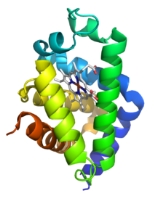
Neuroglobin
Encyclopedia
Neuroglobin is a member of the vertebrate globin
family involved in cellular oxygen homeostasis
. It is an intracellular hemoprotein
expressed in the central and peripheral nervous system, cerebrospinal fluid
, retina
and endocrine
tissues. Neuroglobin is a monomer
that reversibly binds oxygen with an affinity higher than that of hemoglobin
. It also increases oxygen availability to brain tissue and provides protection under hypoxic
or ischemic
conditions, potentially limiting brain damage. It is of ancient evolutionary origin, and is homologous to nerve globins of invertebrates.
Neuroglobin was first identified by Thorsten Burmester et al. in 2000. Italian researchers suggest that neuroglobin is more likely to usher in nitric oxide
to protect neuron survival and recovery in areas where oxygen supply is reduced.
The 3D structure of human neuroglobin was determined in 2003. The next year, murine neuroglobin was determined at a higher resolution.
Globin
Globins are a related family of proteins, which are thought to share a common ancestor. These proteins all incorporate the globin fold, a series of eight alpha helical segments. Two prominent members of this family include myoglobin and hemoglobin, which both bind the heme prosthetic group...
family involved in cellular oxygen homeostasis
Homeostasis
Homeostasis is the property of a system that regulates its internal environment and tends to maintain a stable, constant condition of properties like temperature or pH...
. It is an intracellular hemoprotein
Hemoprotein
A hemeprotein , or heme protein, is a metalloprotein containing a heme prosthetic group- an organic compound that allows a protein to carry out a function that it cannot do alone....
expressed in the central and peripheral nervous system, cerebrospinal fluid
Cerebrospinal fluid
Cerebrospinal fluid , Liquor cerebrospinalis, is a clear, colorless, bodily fluid, that occupies the subarachnoid space and the ventricular system around and inside the brain and spinal cord...
, retina
Retina
The vertebrate retina is a light-sensitive tissue lining the inner surface of the eye. The optics of the eye create an image of the visual world on the retina, which serves much the same function as the film in a camera. Light striking the retina initiates a cascade of chemical and electrical...
and endocrine
Endocrine system
In physiology, the endocrine system is a system of glands, each of which secretes a type of hormone directly into the bloodstream to regulate the body. The endocrine system is in contrast to the exocrine system, which secretes its chemicals using ducts. It derives from the Greek words "endo"...
tissues. Neuroglobin is a monomer
Monomer
A monomer is an atom or a small molecule that may bind chemically to other monomers to form a polymer; the term "monomeric protein" may also be used to describe one of the proteins making up a multiprotein complex...
that reversibly binds oxygen with an affinity higher than that of hemoglobin
Hemoglobin
Hemoglobin is the iron-containing oxygen-transport metalloprotein in the red blood cells of all vertebrates, with the exception of the fish family Channichthyidae, as well as the tissues of some invertebrates...
. It also increases oxygen availability to brain tissue and provides protection under hypoxic
Hypoxia (medical)
Hypoxia, or hypoxiation, is a pathological condition in which the body as a whole or a region of the body is deprived of adequate oxygen supply. Variations in arterial oxygen concentrations can be part of the normal physiology, for example, during strenuous physical exercise...
or ischemic
Ischemia
In medicine, ischemia is a restriction in blood supply, generally due to factors in the blood vessels, with resultant damage or dysfunction of tissue. It may also be spelled ischaemia or ischæmia...
conditions, potentially limiting brain damage. It is of ancient evolutionary origin, and is homologous to nerve globins of invertebrates.
Neuroglobin was first identified by Thorsten Burmester et al. in 2000. Italian researchers suggest that neuroglobin is more likely to usher in nitric oxide
Nitric oxide
Nitric oxide, also known as nitrogen monoxide, is a diatomic molecule with chemical formula NO. It is a free radical and is an important intermediate in the chemical industry...
to protect neuron survival and recovery in areas where oxygen supply is reduced.
The 3D structure of human neuroglobin was determined in 2003. The next year, murine neuroglobin was determined at a higher resolution.

